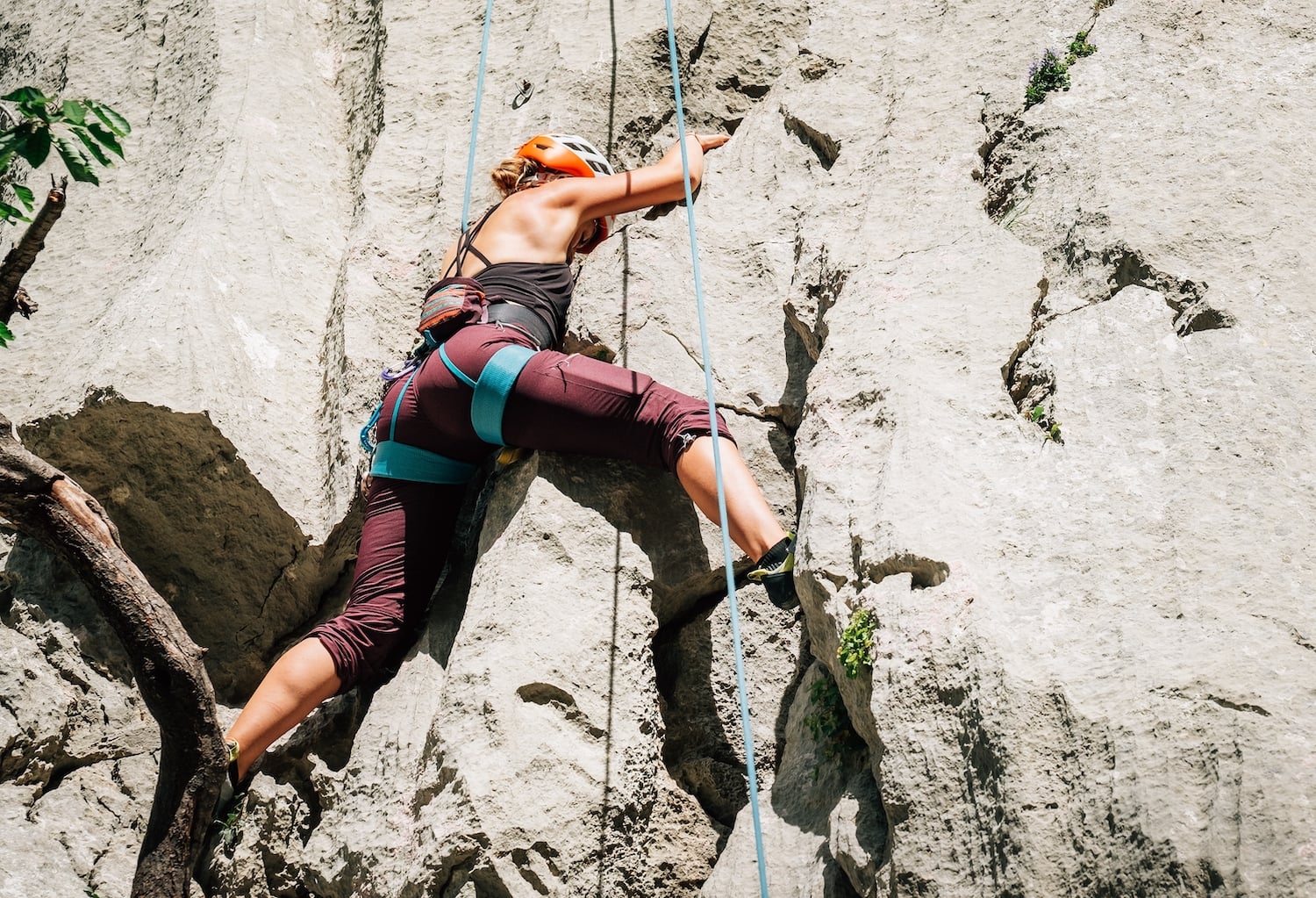
The 9 Best Beginner Climbing Shoes (2024 Guide)
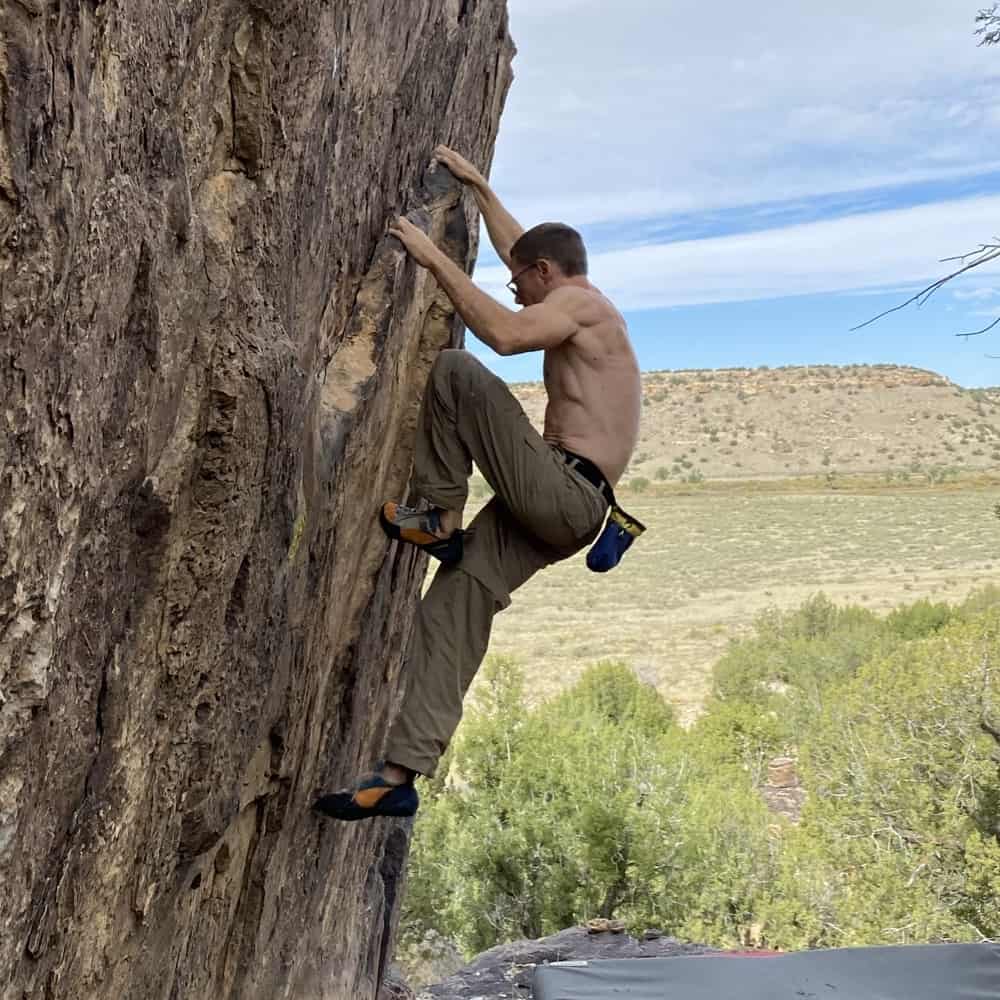
By
Published on July 29, 2022
Updated on December 5, 2023
The growing popularity of outdoor recreation and adventure sports, along with a rapid increase in indoor climbing facilities over the past decade, means the number of new entrants to rock climbing is ever expanding.
One of the first items of gear a neophyte usually purchases is a pair of beginner climbing shoes. Unfortunately for beginners, the explosive growth of rock climbing has also led to the proliferation of new brands and models of climbing shoes for beginners.
With dozens of options, how do you sort them all out and pick the best beginner climbing shoe for you?
Check out the rest of this guide for professional guidance on what to look for and what to avoid, depending on your climbing goals and abilities.
Our Method and Selection Criteria
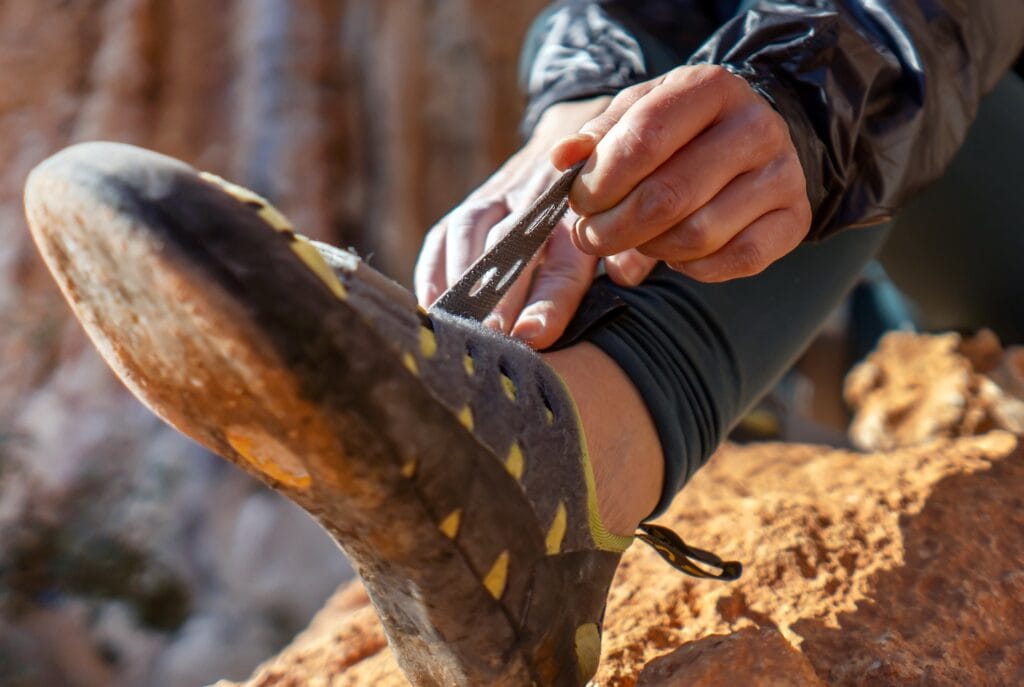
Based on the general needs and preferences of new rock climbers, we narrowed down our pool of candidates for the top beginner picks using the criteria described in our buying guide further down.
We ruled out any climbing shoe models that retail for over $150. The majority of our selections are under $120. There is little reason for a true beginner to spend more, and it could be counterproductive.
We also set an arbitrary limit on the aggressiveness of a shoe’s design. That meant only considering models the manufacturers describe as flat, neutral, or mildly downturned. We also eliminated models with more than mild to medium asymmetry (the amount of inward curve from the heel to the inside of the toe box).
After narrowing down the pool of potential shoes for beginners, we compiled a weighted score using our personal experience with each shoe. We’ve also read customer reviews and forums like Reddit to validate our selection.
Categories

We have chosen nine categories to cover the most common climbing styles and climber types. As a bonus, we picked one alternative choice in each category because we know that every climber has their pet peeve when it comes to climbing shoes.
Although most beginner climbing shoes display similarities in price, comfort, and durability, that doesn’t mean they all work the same. Or that you’ll have the same success no matter which beginner shoe you buy.
Depending on who you are and what type of climbing you aspire to in the future, you will want your first pair of shoes to match your objectives and climbing style. For example, the best shoes for the climbing gym may not perform as well outside when jammed sideways into a crack. Plan to do both? Then go for our first pick!
Our Beginner Shoe Selection
Comparison Table
| Shoe Model | Best for | Vegan | Best Offer |
|---|---|---|---|
La Sportiva Finale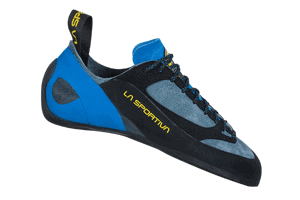 | All-Around | ❌ | Check price → |
La Sportiva Tarantulace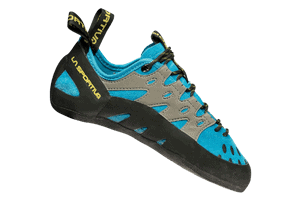 | Budget | ❌ | Check price → |
Evolv Elektra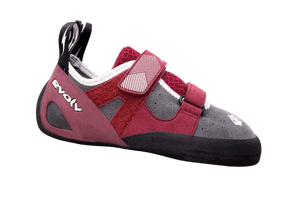 | Women | ✔ | Check price → |
La Sportiva Tarantula Jr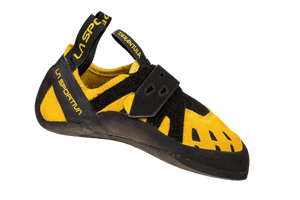 | Kids | ❌ | Check price → |
Scarpa Reflex V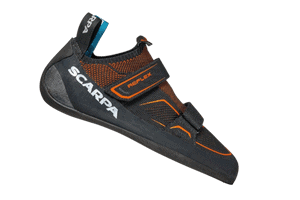 | Gym Climbing | ✔ | Check price → |
La Sportiva Kubo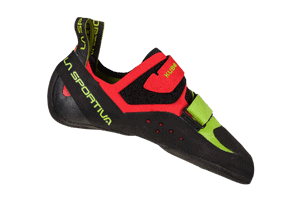 | Bouldering | ❌ | Check price → |
Black Diamond Zone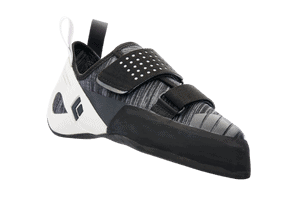 | Sport Climbing | ❌ | Check price → |
La Sportiva Mythos Eco | Trad Climbing | ❌ | Check price → |
Butora Endeavor (Wide)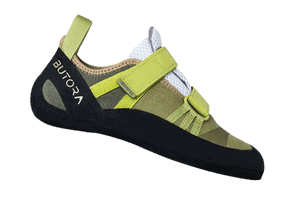 | Wide Feet | ❌ | Check price → |
1. La Sportiva Finale: All-Around Best Beginner Climbing Shoes
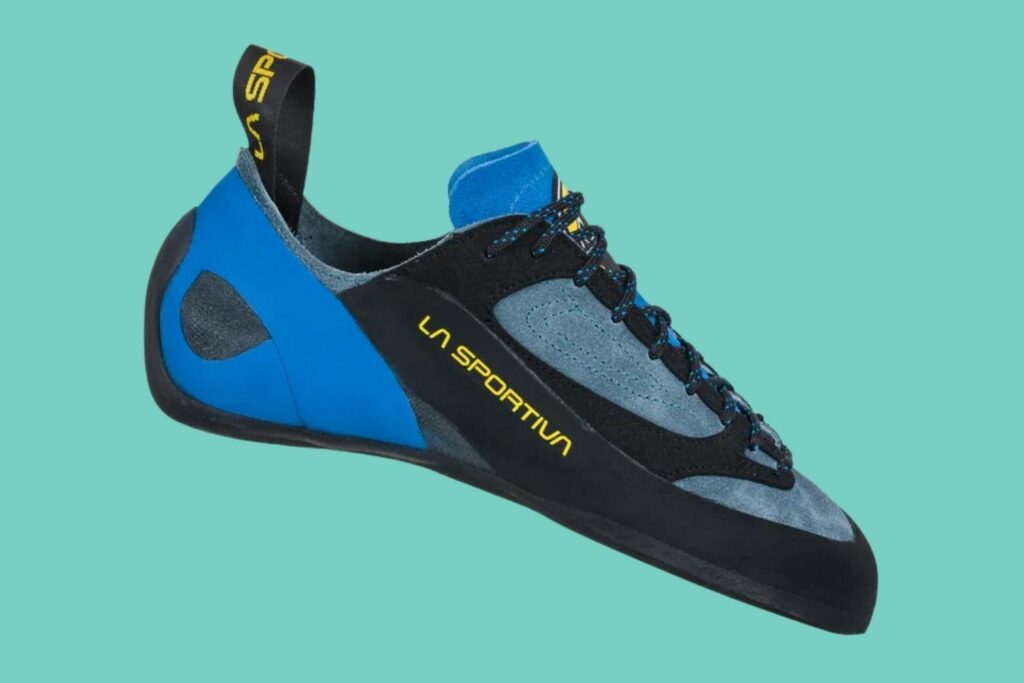
Specifications
Upper Material: Eco-tanned leather with synthetic reinforcements
Outsole Thickness / Material: 5 mm Vibram XS Edge (half-sole, front only)
Midsole: 1.1 mm LaspoFlex
Lining: None
Closure: Laces
Vegan: No
You’ll pay a little more for the La Sportiva Finale than other rock climbing shoes for beginning rock climbers. Why? Without pushing into premium shoe price territory, the Finale offers some design and technology upgrades over the typical entry-level rock climbing shoes.
And while you may be able to find a more adept, specialized shoe at a similar price to the Finale’s $120 retail, you’ll be hard pressed to find something for that price that does everything as competently.
Recently updated with eco-conscious materials and manufacturing processes, the Finale has a mild downturn that helps focus power on edges and overhangs. Yet, it’s still flat and flexible enough to smear and grip with its durable yet grippy Vibram XS Edge outsole. A split-sole design leaves the thick rubber only on the front portion of the shoe. Thinner rubber and a narrower heel cup than its predecessor improve feel and heel hooking proficiency.
The Finale may often be spotted indoors, where it has become a gym climbing favorite. At the same time, both beginners and experienced crack climbers have found that the shoe’s low profile and durability allow it to handle moderate trad climbing easily.
Pros
Cons
Alternative Pick: Black Diamond Momentum Lace
This budget-oriented option to the Finale may be slightly less proficient at steep climbing and edging. However, overall performance is still high enough for anything beginners are likely to tackle. Vegan-friendly materials may sway some shoppers toward the Momentum, with its breathable, mesh knit upper and hemp footbed. The Momentum lace-up model boasts more adjustability and capability than its velcro closure sibling. Buy it here.
2. La Sportiva Tarantulace: Best Budget Climbing Shoes for Beginners
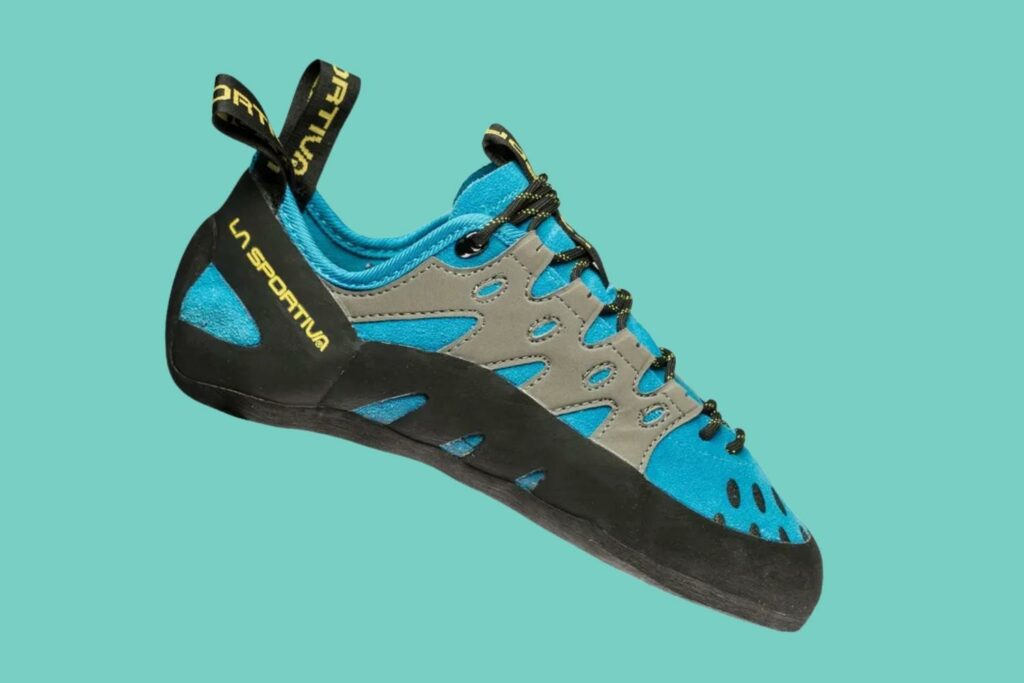
Specifications
Upper Material: Leather with microfiber
Outsole Thickness / Material: 5 mm FriXion RS
Midsole: 1.8 mm LaspoFlex
Lining: Tongue only
Closure: Laces
Vegan: No
Are there less expensive rock climbing shoes than La Sportiva’s newly updated Tarantulace? Yes. Are those other climbing shoes designed by master Italian shoemakers and able to cradle nearly any climber’s foot in a plush but supportive embrace? Probably, definitely not. That’s why we named them the best budget beginner climbing shoes and the best affordable ones for any user.
The Tarantulace was given a design refresh in 2022, with new colors and minor refinements to its materials and construction. It still has a relatively wide toe box, unlined leather uppers that quickly conform to your feet, and a reasonably rigid midsole that eases the strain on your calf muscles when standing on small foot holds.
La Sportiva’s proprietary FriXion RS is a touch less sticky than the compounds found on higher-priced shoes. Still, the priority for beginners is durability, and the 5 mm sole will serve you well until you need a resole or decide to move up to a higher level.
The most significant complaint regarding the Tarantulace’s performance is that its beefy construction and stiff nature inhibit a climber’s ability to feel holds and to grab smaller edges positively. But since beginners aren’t typically attempting routes with those kinds of challenges, this shouldn’t deter a potential first-time rock shoe purchaser.
Pros
Cons
Read the La Sportiva Tarantulace review
Alternative Pick: Five Ten Kirigami
For only a few dollars more than the Tarantulace, La Sportiva’s Italian competitor Scarpa offers the Kirigami. The Kirigami is more sensitive than the Tarantulace, with thinner, 3.5 mm soles of classic C4 Stealth rubber. Synthetic uppers and velcro straps round out this flat, slightly asymmetrical shoe. It offers excellent all-around performance for indoor climbing on anything except uber steep bouldering and sport-leading terrain. Beginners who plan to climb outside a lot may want to choose a different, sturdier pair of shoes. Nearly all first-time climbing shoe buyers sized the Kirigami up from their standard shoe size to achieve a tolerable, pain-free fit. Buy it here.
3. Evolv Elektra: Best Beginner Climbing Shoe for Women
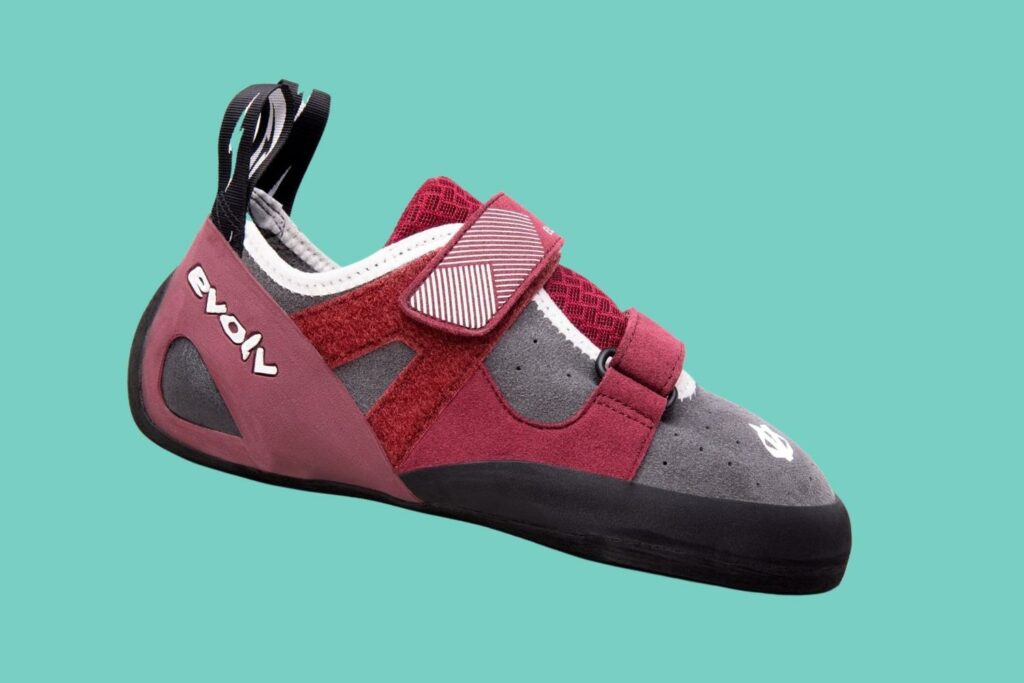
Specifications
Upper Material: Synthratex VX proprietary synthetic
Outsole Thickness / Material: 4.2 mm Trax
Midsole: 1.4 mm MX-P
Lining: Fabric mesh with a padded split tongue
Closure: Velcro
Vegan?: Yes
Many of the shoes listed in other categories are also sold in a women’s model. These “women’s” shoes are typically constructed on a last with a lower volume to accommodate the average woman’s foot versus a male in the same size length.
The Evolv Elektra is the corresponding women’s version of the company’s most popular climbing shoes, the Evolv Defy. Like the men’s model, the Elektra is a neutral, flat-lasted shoe with a synthetic upper and dual velcro straps.
With a wide, rounded toe box, the Elektra doesn’t cram your toes together and accommodates various foot shapes. In contrast to many beginner models, the Elektra is a little softer and more sensitive thanks to a moderate 4.2 mm sole thickness and 1.4 mm midsole.
One unique feature on Evolv branded shoes is the VTR or variable thickness rand. Unlike most climbing shoes that use a single, consistent sheet of rubber, the Elektra has a 3D molded rand that places more rubber on the high wear area at the front of your toes. That delays the inevitable hole worn in the front of the rand that happens to every beginner’s shoes.
Pros
Cons
Alternative Pick: Black Diamond Zone LV
Instead of offering a women’s version of their intermediate performing Zone, Black Diamond sells a low-volume version called the Zone LV in various colors to meet the needs of climbers of any gender. The Zone LV offers a significant performance upgrade from the Elektra but still has an affordable price and Black Diamond’s knit fabric upper for breathable comfort. Be aware these shoes are pretty stiff and have a more finicky fit, so don’t try these unless you aim to take on steeper, more difficult routes. Buy it here.
4. La Sportiva Tarantula Jr: Best Kid’s Climbing Shoes for Beginners

Specifications
Upper Material: Leather
Outsole Thickness / Material: 4 mm FriXion Black
Midsole: None
Lining: Unlined
Closure: Single velcro strap
Vegan: No
Aside from the cool name, the new La Sportiva Tarantula Jr. checks all the other boxes for a young rock climber’s first shoe. A flat, neutral last with a touch of asymmetry and a leather upper with generous volume for all-day pain-free adventures.
This new offering from La Sportiva is a clone of the adult version, with two major differences. First, a single velcro closure makes the shoe even easier for kids to take on and off. And second, the Tarantula Jr is constructed without any midsole to improve flexibility and feel. Since most kids aren’t hopping on long, steep routes or multi-pitch ascents, they don’t need a stiff midsole to aid endurance.
Otherwise, you can expect the same broad range of performance ability and high level of comfort as the adult version of the Tarantula and Tarantulace.
La Sportiva makes the Tarantula Junior in Euro sizes from 26 – 36, equivalent to US 9 (kids) up to 4 (men’s).
Pros
Cons
Alternative Pick: Scarpa Drago Kid
Do you know a kid who’s really into climbing? Maybe they’ve been renting gym shoes for a while and have developed a solid foundation, or they’re psyched to become the next Olympic champion. For those cases, you need a shoe that has the potential to match a young crusher’s growing skills without the frustration caused by loose-fitting or stiff, insensitive kicks. The Scarpa Drago Kid fits the bill. A junior version of Scarpa’s elite bouldering and sport masterpiece, the Drago Kid is just as aggressive in geometry and performance as its parent. The Drago Kid model is offered in sizes 28 – 36 EU (~11 US Youth – 4 US Men’s). Buy it here.
5. Scarpa Reflex V: Best Beginner Shoe for Gym Climbing

Specifications
Upper Material: Zonal Stretch Knit proprietary synthetic
Outsole Thickness / Material: 5 mm Fusion
Midsole: 1.4 mm nylon
Closure: Velcro
Vegan: Yes
The Scarpa Reflex V is a medium-high volume, neutral shoe that is relatively similar to the identically priced Scarpa Origin. However, a few extra features push the Scarpa Reflex V above its corporate sibling for climbing indoors.
The Reflex V’s highlight is the knit upper material that Scarpa calls Zonal Stretch Knit. The one-piece, synthetic upper has superb airflow for moisture management, and its thickness varies to limit stretch to areas where it is beneficial. As another bonus, these vegan-built shoes are washable if they develop an odor.
The Reflex have decent edging power, thanks to a stiff 1.4 mm, 3/4 nylon midsole and 5 mm of Scarpa’s proprietary Vision rubber. A dual velcro strap system works well with the stretchy upper to secure your foot.
Pros
Cons
Alternative Pick: Evolv Rave
This is the only slipper-type shoe selected in our beginner climbing shoe roundup. Generally, we would steer newcomers away from slippers due to difficulty fitting them properly. But Evolv incorporates a tensioned rand that greatly reduces heel bagginess commonly found in slippers, and the Raves seem to fit both narrow and average-to-wide feet fairly well. If you love the idea of the ease and simplicity of a slipper-type shoe, you might want to give the Rave a shot. Its full leather upper will stretch quite a bit, so break-in on these will be harsher than most of our other picks here. Buy it here.
6. La Sportiva Kubo: Best Beginner Bouldering Shoe
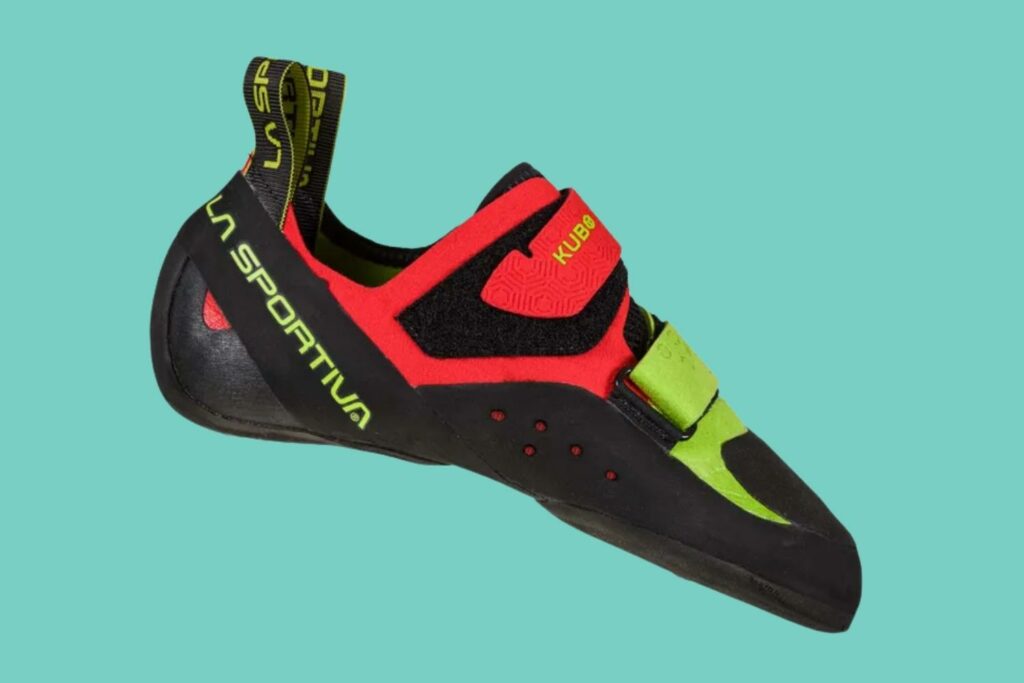
Specifications
Upper Material: Leather and microfiber
Outsole Thickness / Material: 4 mm Vibram XS Edge
Midsole: 1.1 mm Laspoflex
Lining: Unlined
Closure: Velcro
Vegan: No
A good bouldering shoe most often trends toward soft and sensitive construction, with just enough support to maintain the shoe’s downward curving geometry. Since that conflicts with the accepted practice of making a beginner shoe stiff and supportive, we’re picking a more intermediate-oriented shoe that barely falls within our $150 threshold.
The La Sportiva Kubo is certainly a step up in technology and performance aspirations from our other picks, which we feel justifies the higher price if you’re truly committed to the discipline of bouldering. Yet it still offers a high level of comfort compared to an ultra-aggressive shoe.
The Kubo has a thinner outsole (4 mm) and midsole (1.1 mm) than any rock climbing shoes for beginners, which improves feel on technical footwork. The fairly soft shoe has a moderately aggressive downturn and asymmetry, proving much more reliable on smaller edges and steeps than a flatter shoe.
An expansive patch of XS Edge rubber covers nearly the entire toe box to enhance toe hooking security. The Kubo also sports La Sportiva’s top heel rand design, the P3 system that maintains the shoe’s shape and increases support.
Pros
Cons
Read the La Sportiva Kubo review
Alternative Pick: Evolv Kronos / Kira
With a fit that’s almost as plush as the less aggressive Elektra / Defy models, the Evolv Kronos (and corresponding women’s model, the Kira) has a more aggressive appearance that is belied by its welcoming nature. While some might consider the slightly downturned tech fit as better suited for intermediate climbers, the plushness and attractive price of the Kronos make it a good choice for getting into bouldering inside or out. The Kronos medium-stiff yet sensitive platform isn’t just for bouldering; it’s a great all-around performer for beginners with bigger dreams. Buy them here: Kronos (men’s) / Kira (women’s)
7. Black Diamond Zone: Best Beginner Sport Climbing Shoes

Specifications
Upper Material: Synthetic knit
Outsole Thickness / Material: 4.3 mm Fuse
Midsole: (not reported)
Lining: Unlined
Closure: Velcro
Vegan?: No
The Black Diamond Zone is kind of an in-between shoe. They combine the entry-level Black Diamond Momentum knit upper with the aggressively lasted Shadow model. This higher performance makes the Zone one of our more expensive shoes in this guide, but if your climbing goals center on sport climbing at a high level, you’ll need to up the ante.
Climbing steep routes with small edges and overhanging features is easier with a stiffer shoe with a downturned sole. The Zone perfectly matches those requirements. Rather than gaining its rigidity from a stiff midsole, the BD Zone relies on its 3D molded outsole of Fuse rubber to keep its shape and lend support to the minimal midsole.
Reviewers praised the Zone most for its edging ability and the low-profile toe’s fit into smaller crevices and pockets. The knit mesh upper stretches very little, so don’t expect to downsize too much.
Pros
Cons
Alternative Pick: Five Ten Hiangle
The Five Ten Hiangle is a slipper-like shoe with a single velcro strap and an aggressively downturned shape ideal for vertical to overhanging rock. While clearly not designed for beginners, the Hiangle barely fits our price criteria and is reported to fit a wide range of feet in relative comfort. The unlined microfiber upper provides a precise, low-stretch fit that extends to its superior abilities on technical footwork. Encased from toe to heel in dependable C4 rubber, the Hiangle has all the potential you need to go from beginner to comp climber. Buy it here.
8. La Sportiva Mythos Eco: Best Beginner Shoe for Trad Climbing
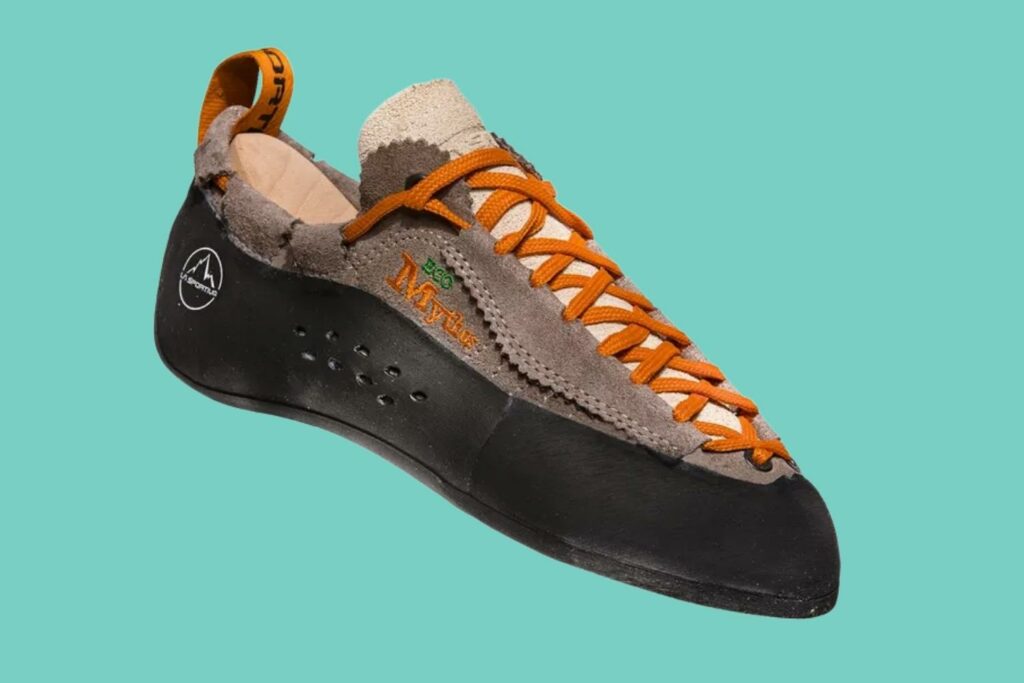
Specifications
Upper Material: Eco-tanned leather
Outsole Thickness / Material: 4 mm La Sportiva ECO
Midsole: 1.1 mm Laspoflex
Lining: Unlined
Closure: Laces
Vegan: No
Most new rock climbers start in the climbing gym these days, but there are still a few who learn at the hands of an old trad master. And like many other forms of outdoor recreation, trad may actually be growing in popularity again.
If you’re going to venture out on more traditional ventures, you’ll want a shoe that won’t hold you back by causing foot pain or performance issues. La Sportiva’s tried and true Mythos has proven itself a reliable trad companion for decades and was recently updated with new, environmentally friendly manufacturing and construction methods.
The upper of the Mythos is renowned for stretching a size or two during break-in as it molds to its owner’s feet. Fortunately, a 1.1 mm midsole helps to stiffen your underfoot platform for edging and smearing on long routes.
But the Mythos Eco isn’t really about edging and smearing. The low profile toe, high rand coverage, and flat fit are more attuned to jamming and other crack climbing techniques.
Pros
Cons
Read the La Sportiva Mythos Eco review
Alternative Pick: Scarpa Helix
The Scarpa Helix is stiff and supportive enough for jamming and edging effectively, an older model shoe with a retro, traditional style. A classic flat lasted shoe with a highly adjustable lacing system, the Helix has a low profile and nicely padded tongue for comfort in crack climbing. A fairly thin 3.5 mm XS Edge outsole helps sensitivity and smearing abilities. Buy it here.
9. Butora Endeavor (Wide): Best Beginner Climbing Shoes for Wide Feet

Specifications
Upper Material: Suede and synthetic
Outsole Thickness / Material: 5 mm Neo Fuse
Midsole: Variable thickness ABS
Lining: Hemp
Closure: Velcro
Vegan: No
Butora is a Korean shoe manufacturer that has developed a great reputation over the past few years for its range of entry-level to elite climbing shoes. They are a pioneer in offering multiple versions of the same shoe model, with narrow, regular, and wide options to suit different foot shapes.
We chose Butora’s beginner-friendly Endeavor Moss (Wide) as our favorite for climbers with wider feet. The Endeavor has a cushy mesh and foam split tongue that envelops your foot in softness. The medium-stiff flex, full hemp lining, and leather footbed provide a solid platform for footwork. The Endeavor’s unusual hybrid upper is made from synthetic in the front to minimize stretch (lighter-colored material) and suede in the back for comfort and breathability (darker material).
Note that the Endeavor wide also comes in a smaller volume version aimed at women, the Endeavor Crimson (Wide). Still wider and higher in volume than other women’s models, the Crimson gets the same high marks from reviewers for its overall competence in all environments.
According to reviewers, you may not want to downsize the Butora Endeavor as much as a similar Scarpa or La Sportiva shoe. Many found their street shoe size to be a good compromise between high performance and comfort.
Pros
Cons
Read the Butora Endeavor review
Alternative Pick: Scarpa Origin
According to Scarpa’s comparative chart of its own shoe models, the Origin has the most relaxed fit with the highest volume of all the company’s rock climbing shoes. Highly durable with quality craftmanship and 5 mm of Scarpa’s Vision rubber, the Origin should last through your early learning phase without fail. Soft leather shoes that are comfortable right out of the box. Buy it here.
What Makes a Good Beginner Climbing Shoe?
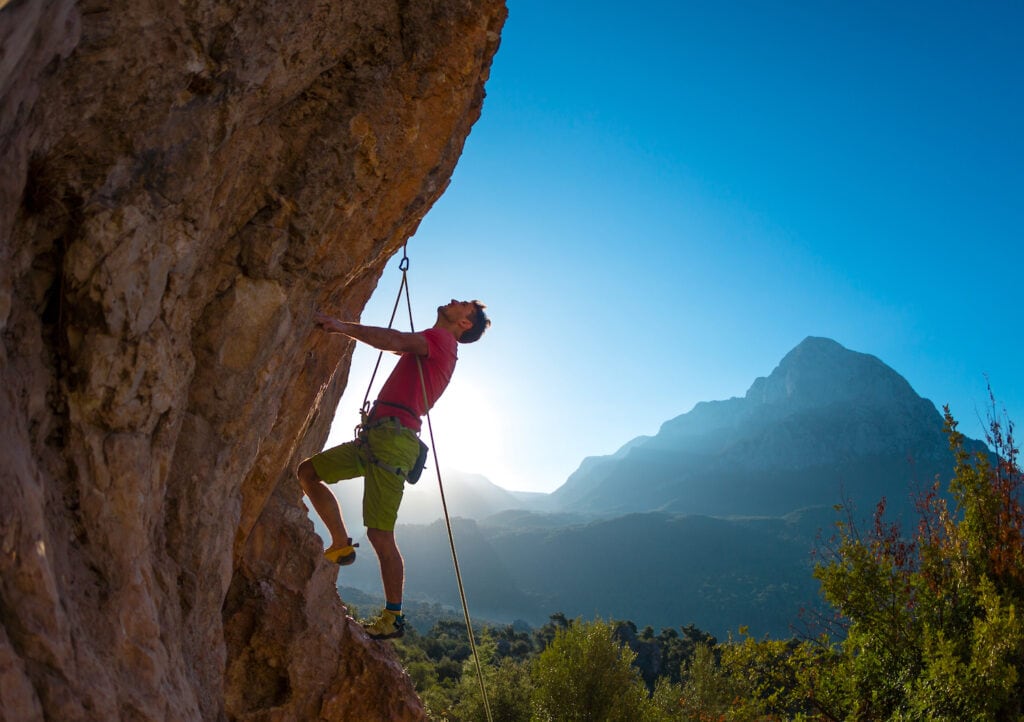
While this is debatable, most companies focus on three general factors when designing and marketing rock shoes for beginners.
Comfort
First, an entry-level climbing shoe must be comfortable with a minimal break-in period. One school of thought for fitting rock climbing shoes is to make them painfully tight upon first wearing so that they provide the best sensitivity and allow you to feel and securely grip smaller edges with the tips of your toes.
However, this philosophy is detrimental to beginner climbers who should be prioritizing learning basic footwork skills and having fun. Try to fit your shoes, so they are uncomfortably snug at worst, but don’t cause any sharp pains or hot spots.
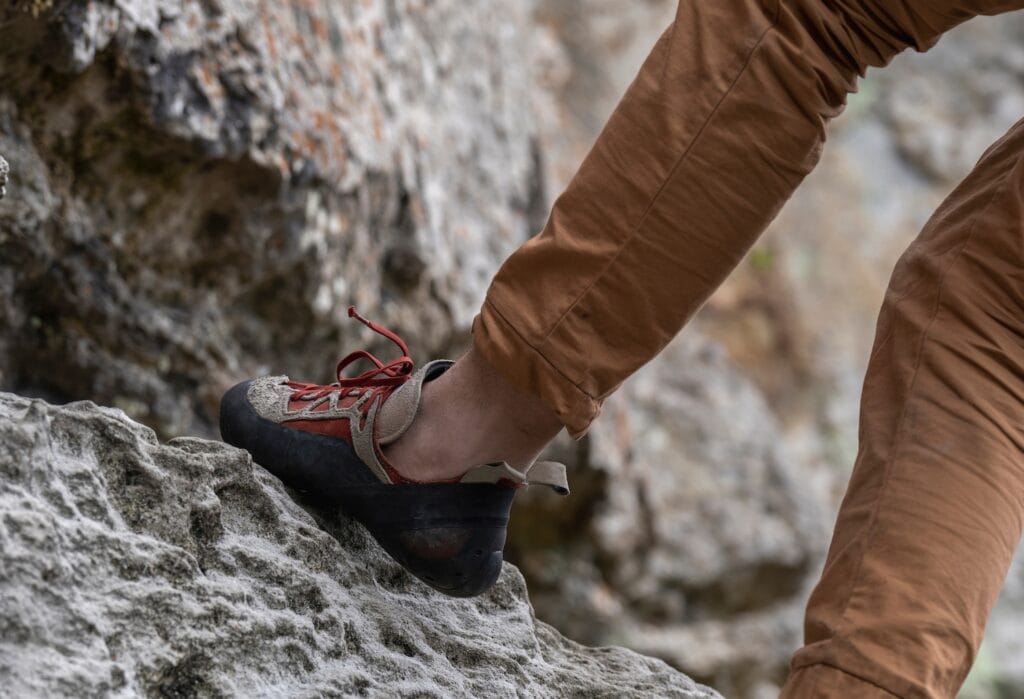
Most beginner climbing shoes are built on a flat, or neutral, last with little downturn. Curved, downturned soles are a feature of higher-performance shoes that help with the smallest footholds and overhanging terrain. Those design features come with a price, though, in the form of smashed toes and contorted arches. Beginners won’t be climbing on rock like that for some time and will have likely worn out their first pair of climbing shoes by then.
Price
Starting a new sport or hobby nearly always requires some investment or expense, and climbing is no exception. But most people don’t want to spend more than necessary to determine whether they love the sport.
For that reason, climbing shoe manufacturers keep most beginner models around $100, plus or minus $20. Not unreasonable for a high-tech piece of equipment, especially considering the price of regular athletic shoes nowadays.
Premium models of climbing shoes from the top brands are currently selling for up to $210, but beginners shouldn’t think that paying more will help them advance more quickly. Climbing shoes built for elite performance have features you don’t need, which may hinder your training and ability to gain fundamental footwork skills.
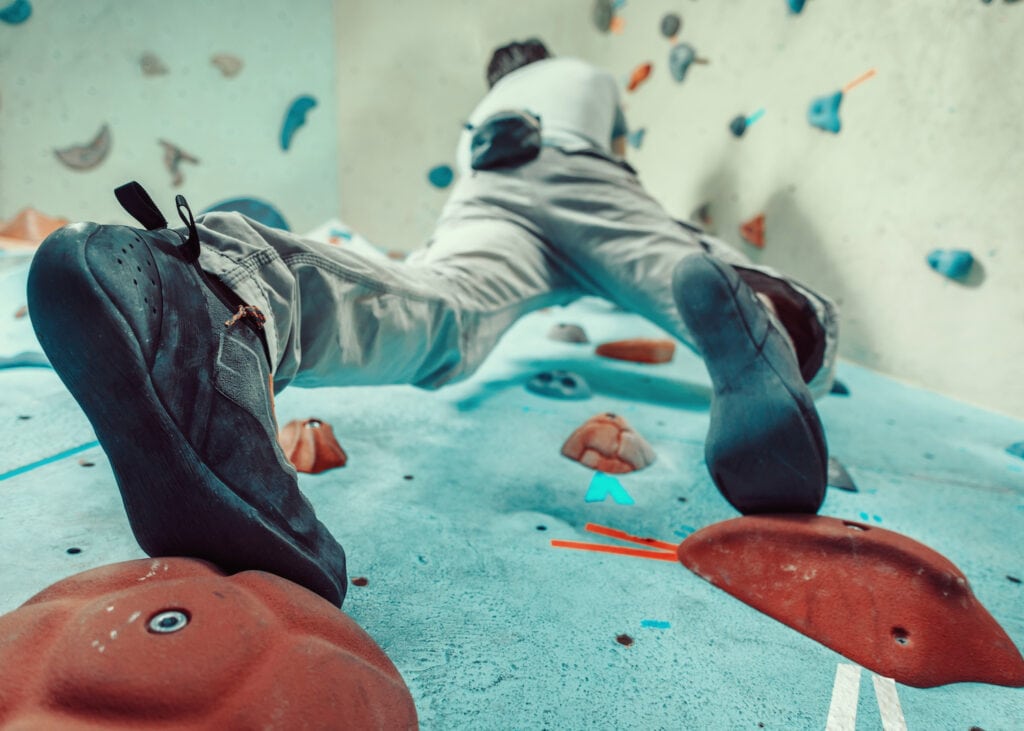
Durability
The final priority for designers and purchasers of beginner climbing shoes is durability. Although beginner shoes may be relatively inexpensive, you still want them to last as long as possible.
First-time climbers often display less than delicate footwork, to put it politely. Dragging their toes or sides of the shoe from one hold to the next, or scratching and scraping their feet on the wall as they search in vain for positive purchase. All of this can be tough on expensive, high-performance shoes that generally employ thin, soft rubber for maximum grip and feel.
For these reasons, a beginner climbing shoe is generally designed with thicker rubber on the sole. The outsole thickness of high-end rock climbing shoes ranges from about 3 – 4 mm, while shoes made for the entry-level market run from 4 – 5 mm.
How to Find the Perfect Climbing Shoes As a Beginner?

Outside of the main considerations of price, comfort, and durability, what else should a beginning rock climber pay attention to when buying climbing shoes for the first time?
Upper Materials
Leather is almost an ideal material for climbing shoe uppers. It naturally breathes and stretches over time to conform to an individual’s foot shape. Leather and suede also seem more odor resistant than most synthetic upper materials. Leather can also stretch so much that a shoe that fits perfectly at first becomes baggy and loose upon extended wearing.
The alternatives to leather are generally synthetic leather-like materials or more recently developed knit-type fabric. Synthetic uppers are intended to combat the inherent stretchiness of leather while also appealing to those who choose not to wear animal-derived products.
Support vs. Sensitivity
The best climbing shoes for edging on vertical terrain have fairly stiff, supportive soles so you can stand on the ends of your toes for long periods without straining your calf and foot muscles. For lower-angle smearing and severely overhanging terrain, it’s often advantageous to wear a softer, more flexible shoe that is better at making surface contact and grasping footholds with your toes. Clearly, climbers who wear only one pair of shoes are forced to compromise in one way or another. If you tend to climb a little bit of everything, stick to something in the middle of the range stiffness-wise. Beginner shoes typically lean toward the more supportive side of the spectrum to help them stick on smaller holds while building up foot strength.
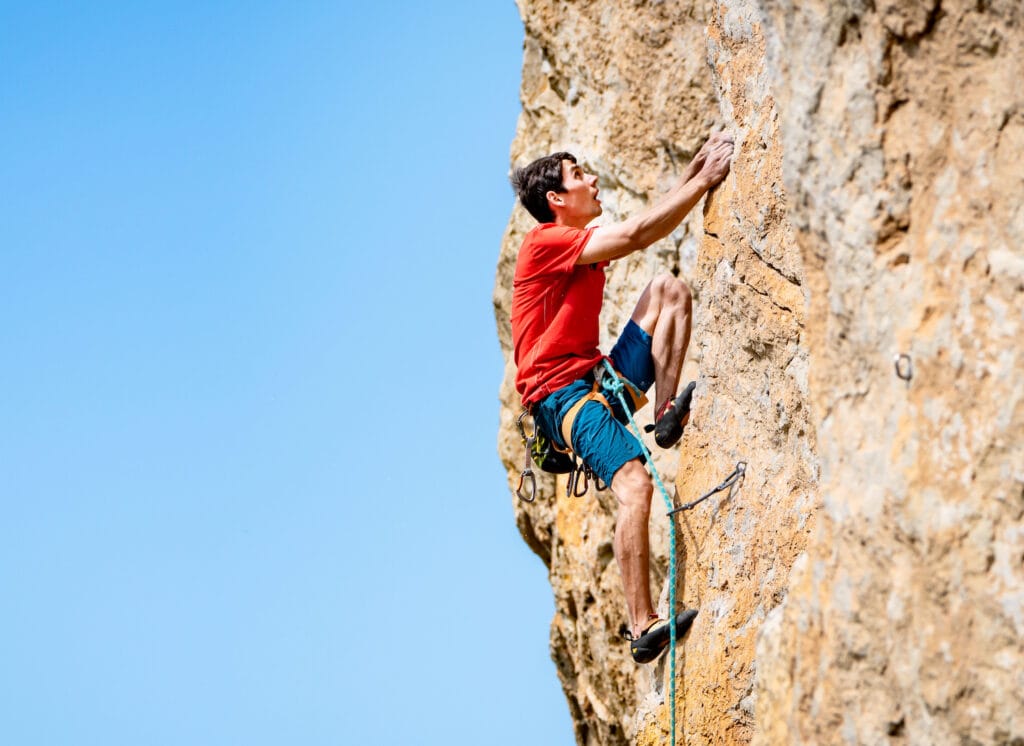
Frequently Asked Questions (FAQs)
First, understand these two basic principles. Number one, even for beginners, your toes must touch the inside of your climbing shoes. Number two, all shoes, even those made from synthetic materials, will stretch out to a certain extent. The ideal state for a first-time climber is for their foot to lay flat, without any curve in the toes, and without their toes being squished together too forcefully.
Laces generally offer the most variability in sizing adjustment. Whether you want to crank the shoes down tight at the toes for better edging or loosen them up on a long multi-pitch, a lace-up shoe allows you to adjust shoe volume from the toe box to your ankle. Velcro is the most convenient for quick on and off but only pulls at two or three attachment points on the sides of the shoes. Velcro straps usually don’t provide much ability to cinch down your toes, so if the shoe doesn’t fit your foot shape, there will always be loose material and empty space inside. Slippers are the easiest to put on and remove and the hardest to obtain a proper, snug fit without undue pain or bagginess.
In the best-case scenario, a new climber will wear out the soles or rand of their first pair of climbing shoes when their skills warrant a more capable shoe. Do your soles still look good, but you’re regularly falling due to your shoes slipping off tiny edges and foot jibs? If your feet are failing you a lot more than your finger strength and upper body endurance, then maybe you need to move on to a model for more advanced climbers.
Beginner rock climbing shoes actually may perform better than more expensive models on the types of terrain that beginners are likely to climb. Pro-level shoes are aggressively downturned and highly asymmetric to focus power on a small spot at the end of your big toe. When you’re standing on larger holds, that focus doesn’t really help and is more likely to simply cause pain. It can be incredibly demotivating to own shoes that cause pain whenever you put them on or stand on a small hold. Flat shoes with a slight asymmetry allow beginners to tap their instinctive climbing abilities and climb naturally, without pain, as their footwork evolves.
Are you looking for a second pair of climbing shoes? Check out our overall selection of the best climbing shoes for 2024.
